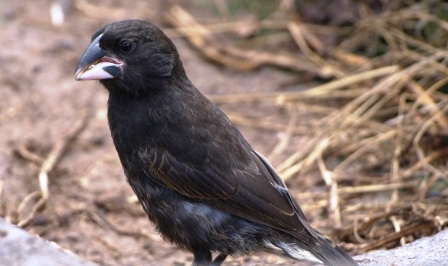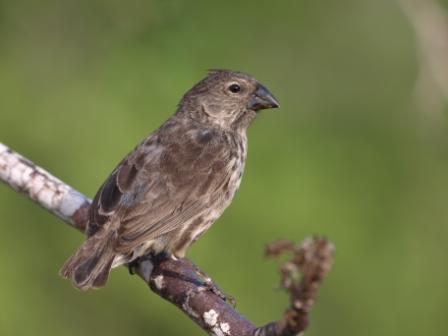And finally, the famous finches

VulcanSpirit
Richard & Alison Brunstrom
Mon 7 May 2012 16:43
|
I'll stop banging on about evolution (no apology -
it's what Galapagos is all about) after this Blog as French Polynesia approaches
rapidly and the stories there, for a change, are less about wildlife and
more about people.
But first, the finches. Darwin identified
artificial selection (selective breeding by humans), sexual selection (breeding
by choice) and lastly, natural selection - selection based upon natural
adaptation and thus fitness to survive. His experience of the birds of Galapagos
was central to the development of his revolutionary theory published twenty
years later.
There are 14 species of 'Darwin's finches'.
Thirteen live in Galapagos, and one on the Isla de Cocos near Costa
Rica. The finches arrived about 2 million years ago from mainland South America
and found Galapagos to have lots of food but few birds so there were lots of
ecological niches (lifestyles) 'available' due to the lack of other competing
bird species. This allowed the finches to undergo rapid adaptive radiation
into these available niches, resulting in an explosion of new species. Many
of the species still look very similar to the original South American immigrants
- they're mainly undistinguished 'little brown jobs'. In some the males are
black, but largely the whole lot of them scarcely deserve a second glance -
until you look at their bills.
Basically the finches' bills have
rapidly evolved to enable the birds to exploit a wider range of food - from
the very fine bill of the insectivorous warbler finches (you'd never guess they
were a finch), to the chunky bills of the woodpecker finch and the range of
bills displayed by the several species of seed eating tree and ground finches.
Several of the finches now use tools - in particular the cactus finches which
use cactus spines held in their beak to probe for and spear hidden insect
grubs.
Here are just a couple to show the variety. The
first is a male Large Cactus Finch Geospiza conirostris, from Espanola.
Note the very large heavy duty bill suitable for cracking a wide variety of
hard seeds - in fact he has a seed in his bill in the photo:
 And here, by contrast, is a female Vegetarian Finch
Platyspiza crassirostris (at least, I think it is; the females of
several species are very similar). You can see the similar but slightly more
slender beak and just make out the crossed bills; she lives on a slightly
different diet:
 Darwin's genius was to realise that the natural
variation he'd seen exploited in artificial selected breeding of domestic
animals was present in all species (he knew nothing of the mechanism of course;
no-one had even dreamt of DNA and genes at that time) and that natural
selective pressures would also enable variation to be exploited. Species that
could adapt would survive and give rise to daughter species thus explaining for
the first time the origin of species. 'His' Galapagos finches remain one of the
very best examples of adaptive radiation ever discovered and a wonderful example
of visible evolution. And it's still happening; recent research shows that at
least one species is in the process of splitting apart at present - presumably
all the ecological niches are still not full. After all, they've only had 2
million years.
|